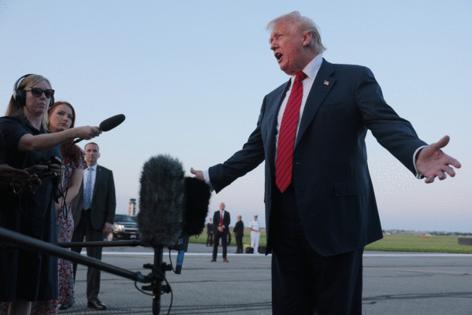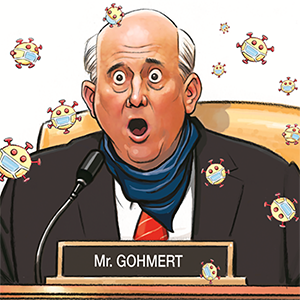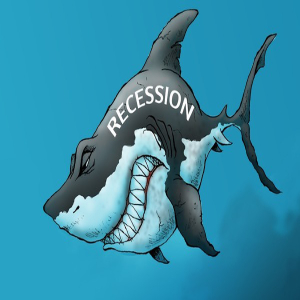Trump says US to hike India's tariffs over Russian oil buys
Published in News & Features
WASHINGTON — President Donald Trump said he would be “substantially raising” the tariff on Indian exports to the U.S. over New Delhi’s purchases of Russian oil, ramping up his threat to target a major trading partner.
“India is not only buying massive amounts of Russian Oil, they are then, for much of the Oil purchased, selling it on the Open Market for big profits,” Trump wrote on his Truth Social platform Monday. “They don’t care how many people in Ukraine are being killed by the Russian War Machine. Because of this, I will be substantially raising the Tariff paid by India to the USA.”
Trump’s post did not specify by how much he would raise the levy. Trump last week announced a 25% rate on Indian exports, shocking New Delhi after months of negotiations failed to secure a breakthrough. He also threatened more duties if India continued to buy oil from Russia.
The U.S. president’s new threat comes ahead of an Aug. 8 deadline for Russia to reach a truce with Ukraine, with the administration threatening so-called secondary sanctions on countries that purchase Russian energy. The U.S. and other allies of Ukraine view those purchases as helping to prop up Russian leader Vladimir Putin’s economy and undercutting pressure on Moscow to end a war that is now in its fourth year.
India has been a top Trump target in the campaign to bring an end to the war in Ukraine. New Delhi has been defiant, however, with Prime Minister Narendra Modi — who has had warm relations with Trump in the past — responding to the U.S. president’s threat by urging Indians to buy local goods and signaling that his administration will continue to buy Russian oil.
Modi’s government hasn’t given Indian oil refiners instructions to stop buying Russian oil, and no decision has been taken on whether to halt the purchases, people familiar with the situation told Bloomberg, asking not to be named due to the sensitivity of the matter.
India has morphed into a major buyer of Moscow’s crude since the invasion of Ukraine in 2022, spurred on by the discounts it receives. On average, the country has been buying Russian crude at a rate of about 1.7 million barrels a day so far this year, according to tanker tracking data compiled by Bloomberg.
India exported about 1.4 million barrels a day of refined fuels in the first half of this year, according to Kpler data compiled by Bloomberg. Diesel or gasoil cargoes made up approximately 40% of total fuel exports, while gasoline and blending components comprised about 30% of the shipments.
Still, quantifying how much oil India exports that’s made specifically from Russian crude is hard because refiners generally consume an array of barrels and then export an even wider range of fuels. The European Union recently launched a package of sanctions that will ban the purchase of fuel made from Russian crude, but traders are still waiting for the body to detail how the measures are going to work in practice.
Any disruption to Indian purchases of Russian oil could force it to look elsewhere for its supplies. Last week, the country’s largest processor purchased several million barrels of crude from the U.S. and UAE in sudden purchases that were both large and for relatively immediate delivery, people familiar with the matter said at the time.
Trade Talks
Trump, in recent weeks, has intensified his rhetoric against India, assailing the country over its tariffs and other barriers to U.S. goods, continued energy buys from Russia and for participating in the BRICS group of developing economies, in particular over the bloc considering alternatives to the U.S. dollar.
The Indian government has indicated it intends to continue talks with the U.S. in hopes of securing lower tariffs. India is considering ramping up natural gas purchases from the U.S., increasing imports of communication equipment and gold.
Officials see those moves as helping to narrow India’s trade surplus with the U.S. — a key concern for Trump. The U.S. had a trade deficit with India of about $43 billion last year, the 11th largest, according to figures from the International Monetary Fund.
But there are a number of sticking points complicating discussions. Modi has been reluctant to open up sensitive sectors like agriculture and dairy to the U.S. India restricts imports of dairy because of rules around animal feed, which can’t be eased because of religious sensitivities.
Relations between Modi and Trump have deteriorated in the U.S. president’s second term. Earlier this year, after clashes between India and Pakistan — both nuclear powers — Trump threatened to cut off trade talks and block access to U.S. markets if the countries did not halt the fighting. Trump has claimed that his actions brought peace, a view that has further rankled New Delhi.
Pressure on Russia
India has been caught in the middle of Trump’s enhanced focus on ending Russia’s war in Ukraine. The president returned to office vowing to quickly end Russia’s invasion but those efforts have been stymied by Putin, who has responded with only maximalist demands for Ukrainian territory and refused calls for face-to-face discussions with Ukrainian President Volodymyr Zelenskyy.
Trump has grown increasingly frustrated with Putin, leading to his latest threats to impose economic penalties in a bid to force his Russian counterpart to negotiate in good faith. Trump has threatened to toughen sanctions on Moscow in the past only to delay action in hopes of preserving negotiations.
Putin has dismissed Trump’s latest effort pressure campaign, saying that his war goals in Ukraine are unchanged.
Trump told reporters on Sunday that special envoy Steve Witkoff would go to Russia this week — on Wednesday or Thursday — for further discussions. Tensions between Washington and Moscow intensified last week when Trump said he had moved two nuclear submarines in response to “highly provocative statements” from former Russian President Dmitry Medvedev.
---------
—With assistance from Julian Lee, Prejula Prem and Simon Casey.
©2025 Bloomberg L.P. Visit bloomberg.com. Distributed by Tribune Content Agency, LLC.







Comments